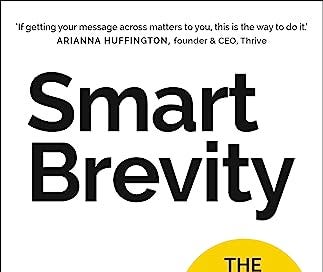Smart Brevity: The Power of Saying More with Less
By Jim VandeHei, Mike Allen, and Roy Schwartz
This book delivers a masterclass in effective communication, as it distills the essence of conveying powerful messages in fewer words, all the while challenging the conventional verbosity in professional and personal exchanges. That is, it advocates for a crisp, clear, and engaging approach.
The authors, seasoned in the art of concise journalism, illustrate how to cut the clutter without losing depth. (They also founded Axios, the news site built around short, to-the-point stories.) Their insights on understanding the audience's attention span and crafting messages that resonate within these constraints are particularly enlightening, especially when, in the online world, people don’t read; they scan.
A few takeaways from the book:
Focus on the essentials. When communicating, it's important to focus on the most important points and eliminate unnecessary fluff. This means taking the time to think about your audience and what they need to know.
Use strong verbs and concrete nouns. Instead of using weak verbs and abstract nouns, use strong verbs and concrete nouns to make your writing and speaking more vivid and engaging.
Avoid jargon and clichés. Avoid using jargon and clichés, which can make your communication sound unprofessional and unoriginal.
Use visuals and structure. Visuals and structure can help to make your communication more scannable and easier to understand.
What I enjoyed most
In 2013, I started executive coaching, mainly to friends and acquaintances who’d enjoyed successful careers but who now wanted to transition to the next thing, which was often consulting, running a small company, or sitting on corporate boards. The first order of business was helping them build a personal brand outside their current company and secure a spot in the digital world.
The second order of business was helping them communicate more effectively—in email, blog posts, social media, presentations, etc. In every single instance, the same problem reared its head: They were too verbose. In the corporate world, where the babble effect reigns supreme, they’d been trained that more words meant more knowledge. I had to teach them the power of conveying their points in fewer words, which is one of many points that Smart Brevity makes very effectively.
The book is not just a guide; it's a great tool to help shorten your writing and make you a better communicator, as it nudges readers to rethink their communication style, ensuring that every word counts. My assessment: The book is a must-read for anyone looking to hone their ability to communicate effectively in the modern information landscape.
An example I found helpful:
Instead of writing:
“I am writing to request a meeting to discuss the new marketing campaign. I am available on Monday afternoon or Tuesday morning. Please let me know which time works best for you.”
You could write:
“Meeting request to discuss new marketing campaign: Monday afternoon? Or Tuesday morning?”
I highly recommend Smart Brevity to anyone looking to communicate effectively online.




